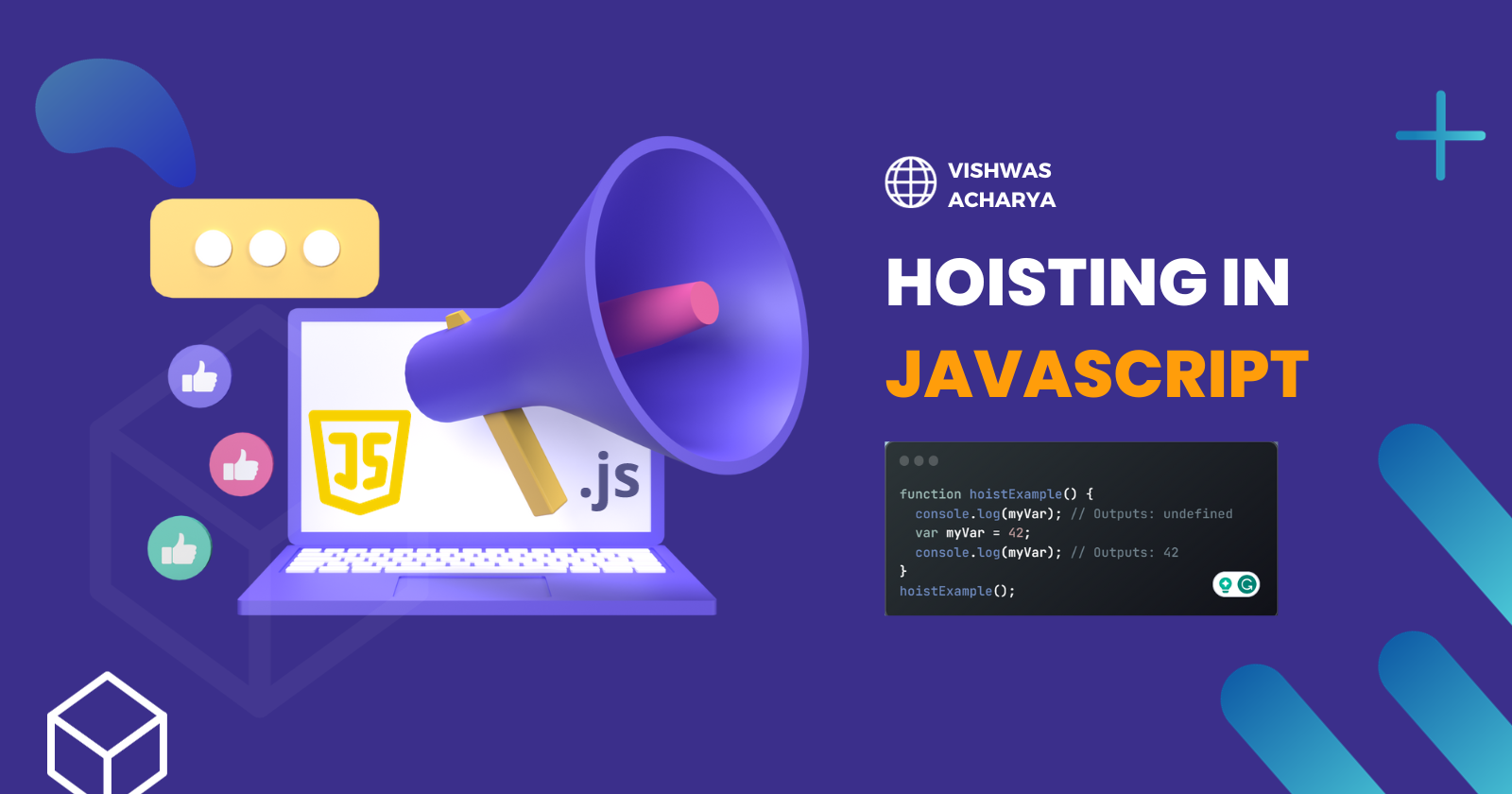Hoisting in JavaScript
 Vishwas Acharya
Vishwas Acharya
Introduction
JavaScript, often referred to as the "language of the web," is a versatile and widely used programming language. It's known for its quirks, and one of these quirks is hoisting. Whether you're a seasoned developer or just starting your coding journey, understanding hoisting is crucial to writing clean and efficient JavaScript code.
In this article, we will take you through the concept of hoisting in JavaScript, shedding light on how variables and functions are hoisted. By the end, you'll not only grasp the hidden mechanism behind hoisting but also learn how to use it to your advantage. So, without further ado, let's dive into the fascinating world of JavaScript hoisting!
What is Hoisting?
Before we delve into the specifics, let's demystify what hoisting means in JavaScript. Hoisting is the behind-the-scenes process that moves variable and function declarations to the top of their containing scope during the compilation phase. This allows you to use them before they are officially declared in your code.
Imagine it like a magician pulling a rabbit out of a hat. The rabbit is your variable or function, and the hat is the JavaScript engine. Hoisting ensures that the magician (JavaScript) always finds the rabbit (variable or function) it needs, no matter where it's placed in the code.
Variable Hoisting
The Magic of var
In the world of JavaScript, variables declared with var exhibit a peculiar hoisting behavior. When you declare a variable using var, it gets hoisted to the top of the function or global scope it belongs to. Consider the following example:
function hoistExample() {
console.log(myVar); // Outputs: undefined
var myVar = 42;
console.log(myVar); // Outputs: 42
}
hoistExample();
In the hoistExample function, we try to log the value of myVar before declaring it. Surprisingly, the first console.log statement doesn't throw an error. Instead, it outputs undefined. This is due to hoisting – the declaration of myVar is moved to the top of the function, making it accessible within the entire scope.
let and const in the Mix
The behavior of var might seem counterintuitive, and it often leads to unintended bugs. To address this, JavaScript introduced let and const, which have a different hoisting mechanism.
function hoistExample() {
console.log(myVar); // Throws a ReferenceError
let myVar = 42;
console.log(myVar);
}
hoistExample();
With let and const, hoisting still occurs, but the variables are not initialized until the actual declaration in the code. This means that trying to access myVar before declaring it will result in a ReferenceError. This behavior promotes cleaner and more predictable code.
Function Declarations vs. Expressions
Function Declarations Hoisting
Just like variables, functions in JavaScript are also hoisted. Let's explore the difference between function declarations and function expressions when it comes to hoisting.
hoistMe(); // Outputs: "I'm hoisted!"
function hoistMe() {
console.log("I'm hoisted!");
}
In this example, we call the hoistMe function before declaring it. Thanks to hoisting, there's no error, and the function executes as expected. Function declarations are hoisted in their entirety, making them available anywhere within their scope.
Function Expressions
Function expressions, on the other hand, have a different hoisting behavior.
hoistMe(); // Throws a TypeError
var hoistMe = function () {
console.log("I'm not hoisted!");
};
In this case, we encounter a TypeError when trying to call hoistMe before its declaration. Function expressions are not hoisted in the same way as function declarations. The variable hoistMe is hoisted, but its assignment to a function is not, which is why calling it before the assignment results in an error.
Scope and Hoisting
To understand hoisting fully, it's essential to grasp the concept of scope in JavaScript. Scopes determine where variables and functions are accessible in your code.
Global Scope
Variables declared outside of any function or code block have global scope. They are accessible from anywhere in your JavaScript code.
var globalVar = "I'm global!";
function accessGlobalVar() {
console.log(globalVar); // Outputs: "I'm global!"
}
accessGlobalVar();
In the example above, globalVar is available in the accessGlobalVar function because it has global scope.
Local Scope
Variables declared within a function or code block have local scope. They are only accessible within the scope in which they are declared.
function localScopeExample() {
var localVar = "I'm local!";
console.log(localVar); // Outputs: "I'm local!"
}
localScopeExample();
console.log(localVar); // Throws a ReferenceError
In the localScopeExample function, localVar has local scope, so it's not accessible outside of the function. Attempting to access it globally results in a ReferenceError.
Common Hoisting Pitfalls
Understanding hoisting is essential to write clean and bug-free code. Here are some common pitfalls to watch out for when dealing with hoisting:
Order Matters
The order of your code can significantly impact hoisting behavior. Variables and functions are hoisted to the top of their containing scope, so if you use a variable or function before declaring it, you may encounter unexpected behavior or errors.
console.log(orderMattersVar); // Outputs: undefined
var orderMattersVar = "Hoisting can be tricky!";
In this case, the console.log statement runs before the declaration of orderMattersVar, resulting in undefined. To avoid this, always declare your variables and functions before using them.
Redefining Variables
When you declare the same variable multiple times within the same scope using var, it doesn't throw an error. The variable is simply reassigned a new value.
var myVar = "First declaration";
var myVar = "Second declaration";
console.log(myVar); // Outputs: "Second declaration"
This behavior can lead to unintended consequences, as redefining variables can make your code harder to understand and maintain. Use let and const to prevent accidental variable redeclaration.
Function Overwriting
In JavaScript, if you declare a function with the same name multiple times, the last declaration will overwrite any previous ones. This can lead to unexpected behavior and bugs.
function myFunction() {
console.log("First definition");
}
function myFunction() {
console.log("Second definition");
}
myFunction(); // Outputs: "Second definition"
To avoid function overwriting, always use unique function names and maintain a clear and organized code structure.
Best Practices for Clean Code
Now that we've explored the nuances of hoisting and the potential pitfalls, let's dive into some best practices to write clean and maintainable JavaScript code.
Declare Variables Properly
To prevent hoisting-related issues, declare your variables at the top of their scope. If you use var, consider switching to let or const to leverage block-scoping, which is more predictable and safer.
function cleanCodeExample() {
var localVar = "I'm declared at the top";
// Rest of your code here
}
By declaring variables at the top, you make your code more readable and reduce the chances of encountering hoisting surprises.
Organize Your Functions
When working with functions, make sure to define them consistently. Use either function declarations or function expressions throughout your codebase to maintain a uniform structure.
// Good practice
function calculateSum(a, b) {
return a + b;
}
// Avoid mixing function declaration and expression
var multiply = function (a, b) {
return a * b;
};
Consistency in your coding style not only enhances code clarity but also minimizes hoisting-related issues.
Wrapping It Up: The Power of Hoisting
JavaScript hoisting is the hidden magic that optimizes code by moving variable and function declarations to the top of their scope, enhancing the language's behavior. Understanding hoisting with various variable declarations and function hoisting allows for cleaner code and expert proficiency. Embracing and mastering hoisting enables more efficient and elegant coding, making it a valuable tool for developers. In conclusion, JavaScript's quirks, including hoisting, should be embraced and leveraged as assets in the coding journey to enhance productivity and coding skills.
#JavaScripthoisting #Variablehoisting #Functiondeclarations #Functionexpressions #ScopeinJavaScript #Cleancode #Variabledeclaration #Bestpractices #JavaScriptquirks #ESLint
By Vishwas Acharya 😉
Checkout my other content as well:
YouTube:
Podcast:
Book Recommendations:
Subscribe to my newsletter
Read articles from Vishwas Acharya directly inside your inbox. Subscribe to the newsletter, and don't miss out.
Written by

Vishwas Acharya
Vishwas Acharya
Embark on a journey to turn dreams into digital reality with me, your trusted Full Stack Developer extraordinaire. With a passion for crafting innovative solutions, I specialize in transforming concepts into tangible, high-performing products that leave a lasting impact. Armed with a formidable arsenal of skills including JavaScript, React.js, Node.js, and more, I'm adept at breathing life into your visions. Whether it's designing sleek websites for businesses or engineering cutting-edge tech products, I bring a blend of creativity and technical prowess to every project. I thrive on overseeing every facet of development, ensuring excellence from inception to execution. My commitment to meticulous attention to detail leaves no room for mediocrity, guaranteeing scalable, performant, and intuitive outcomes every time. Let's collaborate and unleash the power of technology to create something truly extraordinary. Your dream, my expertise—let's make magic happen! Connect with me on LinkedIn/Twitter or explore my work on GitHub.